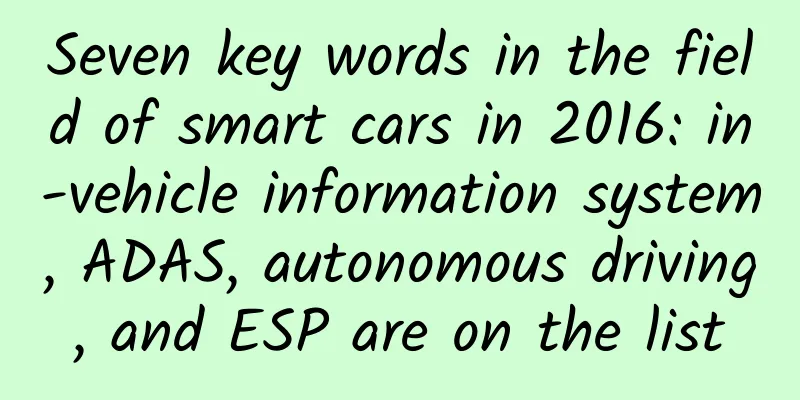Seven key words in the field of smart cars in 2016: in-vehicle information system, ADAS, autonomous driving, and ESP are on the list

|
We no longer see cars as just a means of transportation, but as a considerate friend. As consumers' requirements for car functions and performance increase, cars are gradually shifting towards intelligence, and this change is also a shift from mechanical systems to electronic systems. Currently, the proportion of electrical and electronic components used in cars has increased from 25% to 40% of the total cost of cars. In the future, this proportion will surely increase further. Statistics show that the market is showing an annual growth trend of 7%. Take the in-vehicle telematics system as an example, its market will reach 20 billion US dollars. What are automotive electronics? Automotive electronics can be divided into visible parts and invisible parts, with onboard equipment being the visible part and automotive electronic controllers being the invisible part. From the perspective of use, automotive electronics can be divided into power control systems, safety control systems, body control systems, driving control systems, and information systems. Power control system: including engine management control system, power steering, AT control and ACC Safety control system: including airbags, ABS/ASR and SAFE-BY-WIRE Body control system: including switch control, lighting control, anti-theft system, door lock control, window control, wiper and other body electronic control Driving control system: including instrument, air conditioning and chassis control system Information systems: including entertainment, mobile communications, GPS navigation, and information processing systems As we all know, a car is made up of four parts, namely the body, chassis, engine, and electronic system, and automotive electronics are basically included in the body, chassis, and engine. From the comfort, safety to entertainment of the car, automotive electronics are needed to regulate all aspects. Among cars of different grades and technological content, the proportion of automotive electronics in the total vehicle cost is as follows. Generally speaking, automotive electronics integrates electronic technology, automotive technology, information technology, computer technology and network technology, including three levels: basic technology layer, electronic control system layer and human-vehicle environment interaction layer, and has gone through three development stages: discrete electronic component control, independent component control and intelligent, networked integrated control application. In the global semiconductor acquisition wave, automotive electronics companies have become the most popular. In 2016, there were many acquisitions related to automotive electronics. NavInfo acquired Jefa Technology for 3.875 billion yuan to fill the key link of autonomous driving. Qualcomm acquired NXP Semiconductors of the Netherlands for more than 30 billion US dollars, which became the largest acquisition. Samsung's acquisition of Harman is also aimed at automotive electronics. Although Siemens' acquisition of Mentor is unclear, it is analyzed that it also has a far-reaching relationship with automotive electronics. With the rapid development of the automotive electronics industry today, what are the key words in automotive electronics technology? Keyword 1: Autonomous driving Autonomous driving is sweeping the global automotive industry with a strong momentum. Traditional automakers, auto parts companies, IT communications companies and other forces have been involved in autonomous driving and participated in research and development and manufacturing. Autonomous driving will solve the problems of urban development such as congestion and parking difficulties. Autonomous driving technology can also be used in logistics, shared travel and other fields, with extremely high social and economic benefits. Autonomous driving is no longer just a competition between companies, but has now risen to the level of national strategy. The "national competition" for the leadership of the autonomous driving industry has begun. Yes, this is a battle related to national competitiveness. From sensor supply to software technology integration, to hardware construction, autonomous driving is becoming the next big pie in the automotive industry chain to be snatched. The U.S. Department of Transportation released the first autonomous vehicle regulatory draft issued by a sovereign state on the planet; the strategic goal of the Japanese government is to achieve L4 level fully autonomous driving at the 2020 Tokyo Olympics. The Japanese government hopes to regain its leading position in the industry in Asia by leveraging the strategic opportunity of "autonomous driving"; the Chinese government released an autonomous driving technology roadmap in Shanghai, planning that by 2025, the proportion of new cars with autonomous driving capabilities will reach 15%; the German Ministry of Transport, the state of Bavaria and Audi jointly launched the autonomous driving plan. Since the Tesla driverless car accident, driverless cars have been at the center of controversy. Can driverless cars really replace human driving? I believe that this is inevitable, but it will take time for the technology to mature. Now all companies that develop driverless cars are actively promoting the development of AI systems. Yes, AI will enable cars to learn, think, and judge. 2020 is seen by many industry insiders as a watershed year for the development of autonomous driving. In 2020, autonomous driving technology will become more mature and complete, and some highly autonomous vehicles will appear. Morgan Stanley predicts that by 2030, the scale of the driverless industry will reach 6 trillion US dollars. Keyword 2: Lithium battery The rapid development of new energy vehicles has boosted the market demand for power batteries, which are basically divided into two types: storage batteries (mainly lithium-ion batteries) and fuel cells. However, due to the high R&D and maintenance costs of fuel cells (the maintenance cost of fuel cells is about three to four times that of storage batteries), they are not very suitable for the development of electric vehicles at this stage. Facing the upcoming "blowout" of new energy vehicles, lithium batteries seem to have become a magic weapon for success. At present, lithium battery companies are facing the dilemma of insufficient upstream raw materials and rapidly rising costs; lithium batteries in electric vehicles have fatal problems such as slow charging, short driving range and short life. The average service life of lithium batteries in ordinary electronic products is 8 years, while the service life in electric vehicles is only 3-5 years; when the battery capacity of an electric vehicle decays to less than 80%, the mileage of the electric vehicle will be significantly reduced. When the battery capacity decays to less than 70%, the battery must be replaced, but the battery accounts for about 40% of the total cost of the car, and replacing the battery is a huge expense. Why do lithium batteries in electric vehicles seem so "fragile"? The impact of the working environment and large-scale charging and discharging lead to the problem of short service life, which is also a problem that cannot be changed. Thanks to strong market demand, my country's lithium battery industry has ranked first in the world, and has initially formed four major industrial regions: the Pearl River Delta, the Yangtze River Delta, the Beijing-Tianjin-Hebei region, and the Central Plains. Qinghai, which has 80% of the country's lithium reserves, is trying to build another lithium industry base with national influence, relying on its rich lithium resources to get a share of the lithium battery market. Although we are part of the first camp, there is still a gap between our country and the top companies in South Korea and Japan in terms of technological level. For example, there is still a large gap in product consistency. For the lithium battery industry, improving battery recycling and reducing environmental pollution are important factors in ensuring the sustainable development of the industry. However, the recycling cost of used power batteries is high, and the recycling level of enterprises is not high. This is the pain point of my country's lithium battery industry and one of the main gaps with developed countries. Keyword 3: In-vehicle information system The in-vehicle infotainment system is an intelligent system with diverse interaction methods and powerful graphics functions. In recent years, the originally closed and conservative in-vehicle system has ushered in a new wave of competition, and the market structure and product form will inevitably undergo a major transformation. Under the conditions of meeting the requirements of comfort, entertainment and information, the in-vehicle infotainment system is gradually developing in the direction of performance integration and increasing proportion. The previous single performance has gradually expanded to a multimedia information interaction device that integrates image entertainment, car navigation, wireless communication, etc. As an important node of the vehicle's electrical and network functions, the in-vehicle infotainment system plays an important role in displaying and feeding back the vehicle's status and information. How to gain a foothold in the high-end car market through unique in-vehicle system design has become a question that all major manufacturers are thinking about. Samsung's acquisition of Harman is clearly its first step. The functions of the infotainment system involve the integration of multiple technologies such as human-computer interaction, audio/video signals, wireless signals, hard-wired signals and bus signals. Keyword 4: Advanced Driver Assistance System (ADAS) The recognized paths for the development of smart car technology and industry are advanced driver assistance (ADAS), partial autonomous driving, highly autonomous driving, fully unmanned driving, and smart car stages. The Advanced Driver Assistance System (ADAS) uses a variety of sensors installed on the car to sense the surrounding environment at any time while the car is driving, collect data, identify, detect and track static and dynamic objects, and combine the navigation map data to perform systematic calculations and analysis, so that the driver can be aware of possible dangers in advance, effectively increasing the comfort and safety of car driving. ADAS is not designed to control the vehicle, but to alert the driver to potential dangers and improve driving safety. These active safety technologies are implemented through advanced driver assistance systems that use radar, cameras, and lidar sensors. For example, lane departure warning systems use CMOS camera sensors, night vision systems use infrared sensors, adaptive cruise control systems (ACC) usually use radar technology, and parking assistance systems use ultrasonic technology. A typical ADAS application integrates many technologies, as shown in the figure below. There are two development trends of ADAS in the future : From early warning system to intervention system The main function of ADAS at present is to remind the driver in critical situations, but in the future it will develop into an intervention system, that is, to control the car under limited circumstances. For example, the camera system will develop from a lane departure warning system to a lane control system. Combination of active and passive safety systems The passive safety system and active safety ADAS in a collision are independent of each other, but in the future the two will have better correlation and integration points, such as preparing airbags when onboard lidar, radar or video sensors detect an unavoidable collision. As things stand, the challenges facing ADAS mainly come from four aspects: processors, sensors, software algorithms and maps. ADAS systems require ECUs and MCUs with multi-core architectures, higher frequencies, and lower power consumption processors. ADAS systems need to use some devices to obtain real-time information about the surrounding environment. Radar and Lidar are relatively good recognition sensors, but they are both expensive. The algorithms running on ECUs and MCUs need to use real-time surrounding information obtained by sensors to decide how the car should move. In places where GPS fails, accurate map systems can help avoid accidents. Manufacturers such as Intel, NVIDIA, Panasonic, Qualcomm, Samsung and Sony are actively deploying ADAS-related sensors, ECUs, MCUs, operating systems, chip systems, etc. Industry insiders generally predict that the growth rate of ADAS from 2015 to 2020 will be at least 10%. Keyword 6: Electronic body stability system Electronic Stability System, called ESP by Bosch, DSC by BMW and ESC by GM, is used to improve the stability of the car during driving, or to reduce the risk of loss of control. The Electronic Stability System (ESP) is a milestone in the improvement of active safety control technology of vehicles after the Anti-lock Braking System (ABS) and Traction Control System (TCS). The vehicle stability system "feels" the vehicle's condition through many sensors on the vehicle. Usually, there are four wheel speed sensors to monitor the rotation speed of each wheel, a steering wheel angle sensor to detect the driver's steering, and a body angle sensor to monitor the deflection of the vehicle. In addition to the sensors, a computer is also needed to monitor the vehicle's condition at all times so as to give the sensors the correct instructions. Theoretically, the electronic body stability system can play a good role in any situation, but ESP is only an auxiliary function, which is subject to the system's reaction speed and tire limit. When the speed is too fast or the car is seriously out of control, the body stability system will be powerless. However, the technology has become more and more mature, and its function and effect are very good even on icy and snowy roads. Because of this, many countries and regions have now made this system a mandatory standard configuration for cars. Keyword 7: Internet of Vehicles The Internet of Vehicles is not a new topic. Since 2010, it seems that any product or business related to automobiles and communications can be labeled as "Internet of Vehicles". What exactly is the Internet of Vehicles and how should it be defined? The initial application of Internet of Vehicles originated from electronic sensor devices, in-vehicle entertainment systems, vehicle management, traffic management and other application forms. Today, it is a general term for business models related to car purchase, driving, riding, maintenance, repair, social interaction and trading, which utilizes modern communication technology and combines relevant car operation and driving data. Its ultimate goal is to improve the driving experience, increase car efficiency and reduce car costs. The historical interpretation of Internet of Vehicles is shown in the figure below. To put it simply, maps are the foundation of the Internet of Vehicles, on-board systems and smart hardware are the bridges that connect the car to the Internet, cloud services are the guarantee of all functions, content and automobile manufacturers are the carriers of the implementation of functions, and drivers are the ultimate beneficiaries and feedback recipients of the Internet of Vehicles. Today, the upgrade of communication technology will give real meaning to the Internet of Vehicles, and the development of the automotive aftermarket and the rise of new energy vehicles will promote the development of the Internet of Vehicles industry. Some analysts believe that the future Internet of Vehicles will show the following development trends: on the one hand, the way of interacting with vehicle terminals through voice input will still be the trend of vehicle terminal development; on the other hand, navigation technology will be more intuitive and easy to use, and traditional static navigation will gradually be replaced by dynamic navigation. 3D navigation, real-scene navigation and online methods will all become future development directions. The Internet of Vehicles is part of the Internet of Things, where everything is connected. Traditional semiconductor companies such as NXP, Infineon, Renesas, STMicroelectronics, and Texas Instruments have all made investments in this market. New technology companies such as Google, Baidu, Didi, and Uber are also trying to leverage their advantages in software systems such as artificial intelligence and algorithms to enter this market and launch overall solutions that integrate software and hardware systems. This cake is huge in the future, and the only question left is how to eat it. Cars are becoming more and more important in our lives, and the future of cars will inevitably develop in a more intelligent and diversified direction. Whether it is Tesla's ambition or Apple's outside car manufacturing, it can be predicted that the output value of automotive electronics per vehicle will continue to increase. Although the core technology and market of global automotive electronics products are currently concentrated in Europe, the United States, Japan and other places, with the transfer of the automobile manufacturing industry to emerging countries and regions, China, India, South America and other countries will become emerging markets for automotive electronics and are developing rapidly. Source: Peninsula Coffee |
>>: Always falling asleep in class? It may be a rare disease!
Recommend
What should women with cold uterus and cold blood eat?
It is very important for women to protect their u...
32 weeks head circumference standard table
We all know that, generally speaking, the head ci...
Why is the menstrual blood black?
When women are menstruating, the color of the blo...
Can I take a pregnancy test in the afternoon?
When a woman finds that she may be pregnant, she ...
Gout--This is the 3328th article of Dayi Xiaohu
This is the 3328th article of Da Yi Xiao Hu After...
Is there a problem with the second degree of leucorrhea cleanliness?
For a woman, special physical conditions cause he...
Wear or not wear? The dispute over masks between the East and the West is not just about whether masks are useful or not
The COVID-19 pandemic is spreading around the wor...
What is the cause of brown leucorrhea and itching?
Some friends often experience symptoms of brown a...
Dietary taboos for polycystic ovary disease
Polycystic ovary disease is also a common gynecol...
How to prepare fresh sea cucumbers and freeze them? How to soak dried sea cucumbers?
Dried sea cucumbers are made from processed sea c...
What to do if ovarian teratoma recurs? Chinese medicine diet therapy secret recipe
Ovarian teratoma is a type of tumor that is parti...
Why does it hurt when women urinate?
Urination is something people need to do every da...
What are the symptoms of cervical dysplasia?
Some women do not have any gynecological symptoms...
Can eating sashimi with wasabi "kill insects"? Can looking at green more often protect your eyesight? Here comes the June science rumor list →
1. If a baby has a fever, you can use the method ...
What to do if a woman has poor digestion
Nowadays, many people are under great pressure in...









